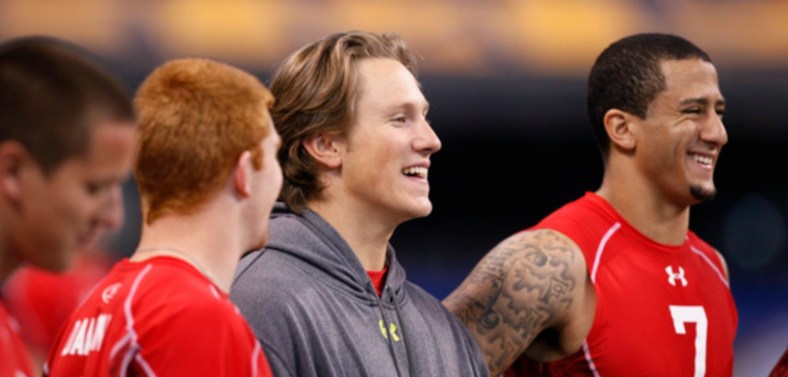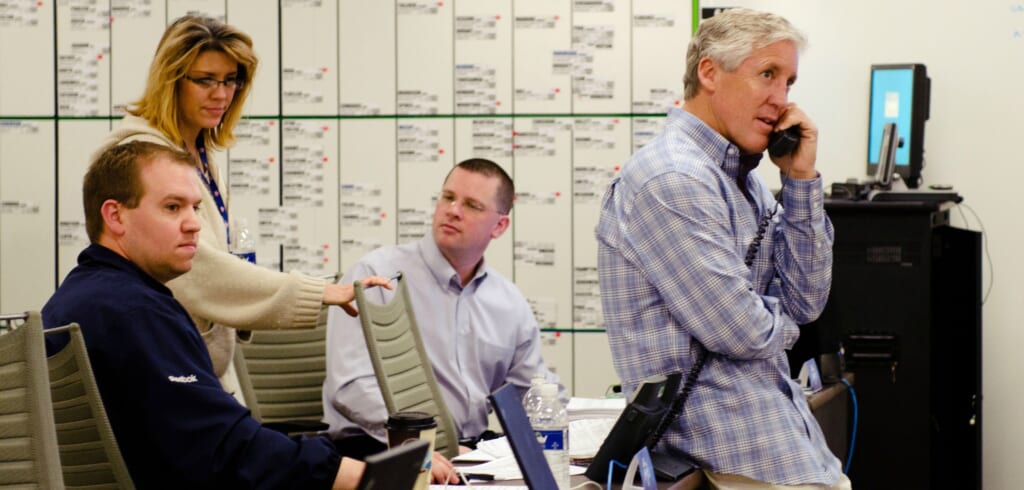
The NFL draft is almost here and general managers and coaches all lover the league are struggling with difference scenarios to help their teams improve. Compared to previous drafts, this one is unique in that there is no clear choice for the top pick, which leads to many potential scenarios that make draft strategies more difficult.
The position that seems to be the most difficult to develop strategies around, is the quarterback position. Every year there are roughly a half-dozen teams looking to get their franchise signal caller that will lead them to the promise land. It’s that simple right? Depending on what fans (and from what team) you ask, it sure sounds like it.
This year’s quarterback draft class is weaker than years past in terms of top-level talent, but strong in terms of sexy names. The success of non-first round picks such as Russell Wilson, Colin Kapernick and Andy Dalton, combined with absolute first-round busts in Blaine Gabbert, Christian Ponder and Brandon Weeden, no doubt have general managers pulling their hair out while deciding what course of action to take. Add the fact that Andrew Luck almost single handedly turned around the Indianapolis Colts franchise, and you’ve got some serious pressure put on the general managers and coaches to find the right quarterback.

Photo: ROD MAR/SEATTLE SEAHAWKS)
Perhaps there needs to be a new strategy that would allow general managers to “keep the funnel full,” while not having to invest as much risk and expectation to the quarterback position. Key word is “perhaps.”
The strategy: draft quarterbacks using two tiers.
Tier one: rounds one and two.
Tier two: rounds three through five.
Every two years, draft a quarterback (regardless of quarterback situation).
Every other draft, you select a quarterback from the opposite tier you selected from two years prior.
Result: Every four years you have a high rated quarterback and a middle of the road rated quarterback.
Here is a look at the quarterbacks drafted every two years since 2006.
2006
| 1 | 3 | Tennessee Titans | Vince Young | QB | Texas |
| 1 | 10 | Arizona Cardinals | Matt Leinart | QB | USC |
| 1 | 11 | Denver Broncos | Jay Cutler | QB | Vanderbilt |
| 2 | 49 | New York Jets | Kellen Clemens | QB | Oregon |
| 2 | 64 | Minnesota Vikings | Tarvaris Jackson | QB | Alabama State |
| 3 | 81 | San Diego Chargers | Charlie Whitehurst | QB | Clemson |
| 3 | 85 | Kansas City Chiefs | Brodie Croyle | QB | Alabama |
| 4 | 103 | New York Jets | Brad Smith | QB | Missouri |
| 5 | 148 | Green Bay Packers | Ingle Martin | QB | Furman |
| 5 | 164 | Pittsburgh Steelers | Omar Jacobs | QB | Bowling Green |
| 6 | 193 | Cincinnati Bengals | Reggie McNeal | QB | Texas A&M |
| 6 | 194 | Tampa Bay Buccaneers | Bruce Gradkowski | QB | Toledo |
| 7 | 223 | Atlanta Falcons | D. J. Shockley | QB | Georgia |
2008
| 1 | 3 | Atlanta Falcons | Matt Ryan | QB | Boston College |
| 1 | 18 | Baltimore Ravens | Joe Flacco | QB | Delaware |
| 2 | 56 | Green Bay Packers | Brian Brohm | QB | Louisville |
| 2 | 57 | Miami Dolphins | Chad Henne | QB | Michigan |
| 3 | 94 | New England Patriots | Kevin O’Connell | QB | San Diego State |
| 5 | 137 | Minnesota Vikings | John David Booty | QB | USC |
| 5 | 156 | Pittsburgh Steelers | Dennis Dixon | QB | Oregon |
| 5 | 160 | Tampa Bay Buccaneers | Josh Johnson | QB | San Diego |
| 5 | 162 | New York Jets | Erik Ainge | QB | Tennessee |
| 6 | 186 | Washington Redskins | Colt Brennan | QB | Hawaiʻi |
| 6 | 198 | New York Giants | Andre’ Woodson | QB | Kentucky |
| 7 | 209 | Green Bay Packers | Matt Flynn | QB | LSU |
| 7 | 223 | Houston Texans | Alex Brink | QB | Washington State |
2010
| 1 | 1 | St. Louis Rams | Sam Bradford | QB | Oklahoma |
| 1 | 25 | Denver Broncos | Tim Tebow | QB | Florida |
| 2 | 48 | Carolina Panthers | Jimmy Clausen | QB | Notre Dame |
| 3 | 85 | Cleveland Browns | Colt McCoy | QB | Texas |
| 4 | 122 | Philadelphia Eagles | Mike Kafka | QB | Northwestern |
| 5 | 155 | Arizona Cardinals | John Skelton | QB | Fordham |
| 5* | 168 | San Diego Chargers | Jonathan Crompton | QB | Tennessee |
| 6 | 176 | Tennessee Titans | Rusty Smith | QB | Florida Atlantic |
| 6 | 181 | Chicago Bears | Dan LeFevour | QB | Central Michigan |
| 6 | 199 | Minnesota Vikings | Joe Webb | QB | UAB |
| 6* | 204 | Carolina Panthers | Tony Pike | QB | Cincinnati |
| 7 | 209 | Buffalo Bills | Levi Brown | QB | Troy |
| 7 | 239 | New Orleans Saints | Sean Canfield | QB | Oregon State |
| 7* | 250 | New England Patriots | Zac Robinson | QB | Oklahoma State |
2012
| 1 | 1 | Indianapolis Colts | Andrew Luck | QB | Stanford |
| 1 | 2 | Washington Redskins | Robert Griffin III | QB | Baylor |
| 1 | 8 | Miami Dolphins | Ryan Tannehill | QB | Texas A&M |
| 1 | 22 | Cleveland Browns | Brandon Weeden | QB | Oklahoma State |
| 2 | 57 | Denver Broncos | Brock Osweiler | QB | Arizona State |
| 3 | 75 | Seattle Seahawks | Russell Wilson | QB | Wisconsin |
| 3 | 88 | Philadelphia Eagles | Nick Foles | QB | Arizona |
| 4 | 102 | Washington Redskins | Kirk Cousins | QB | Michigan State |
| 6 | 185 | Arizona Cardinals | Ryan Lindley | QB | San Diego State |
| 7* | 243 | Green Bay Packers | B. J. Coleman | QB | Chattanooga |
| 7^ | 253 | Indianapolis Colts | Chandler Harnish | QB | Northern Illinois |
For those of you who thinking “don’t draft anyone in the sixth or seventh round?! That’s where Tom Brady was drafted,” stop it. Right now. Look at the list above and tell me how many Tom Brady-type players are on there. Zero. Save your breath and use that pick on a running back.
Assuming that most tier-one quarterbacks aren’t playing from week one of their rookie season, the tier two draft (2008 in this case) would be used for insurance. If the pick from two years ago shows some potential, perhaps you focus on guys in the fourth round. If you are desperate, you focus more in the third. In this scenario, it is likely this tier two quarterback will be the fan favorite and the fans will want him to get his shot at tier one’s spot (assuming he’s not an Andrew Luck after two seasons).
Teams who struggle to find a signal caller are constantly picking in the top five (Browns, Buffalo Bills, Jacksonville Jaguars to name a few). Those teams are more than a quarterback away from being contenders, which makes this strategy even more important. If you draft a tier-one quarterback every four years, while having a high first-round pick due to a poor record, the chances of you hitting a franchise guy should increase.
Rather than putting so much focus on a yearly/bi-yearly basis, the “stability” of this strategy should help the front office focus on different initiatives. On top of that, it should also allow the quarterbacks to gain trust in the system due to the expectations that have been laid out. Unless they are a very high pick, the rookies will know they aren’t the man in their first year. The tier two guys know they will get a shot if tier one guy isn’t getting it done. By the time tier two guy has been labelled successful or a bust, another tier one guy is in the door.
The quarterback position is one of the few that rarely has a franchise type player become available via trade or free agency. Other positions can be filled through this avenue, but not the quarterback. A solid strategy of drafting quarterbacks, like the one I just presented, is something I’d encourage a team like the Vikings to try. Starting with this weekend’s draft.
Photo: Joe Robbins/Getty Images